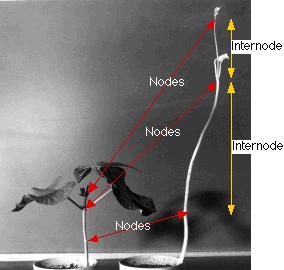
The stems of plants raised in the dark elongate much more rapidly than normal, a phenomenon called etiolation. It is a mechanism that increases the probability of the plant reaching the light.
Once light shines on it, the plant begins to produce internodes of normal size and its leaves grow to full size.
The image shows seedlings of the common garden bean grown in the light (left) and in darkness (right). The pale color of the dark-grown plant is caused by the lack of chlorophyll. When the food reserves of its seed are used up, the seedling will die (unless placed in the light).
Each seedling has three nodes (the bottom ones where the cotyledons were attached), but the internodes are greatly elongated in the dark-grown seedling.
This response is NOT dependent on photosynthesis, because light too dim to be useful in photosynthesis nevertheless halts etiolation. Exposure to dim
The red/far red effect is probably mediated by phytochrome.
The effect of blue light is probably mediated by a pigment related to the blue-absorbing cryptochrome responsible for phototropism.
| Welcome&Next Search |